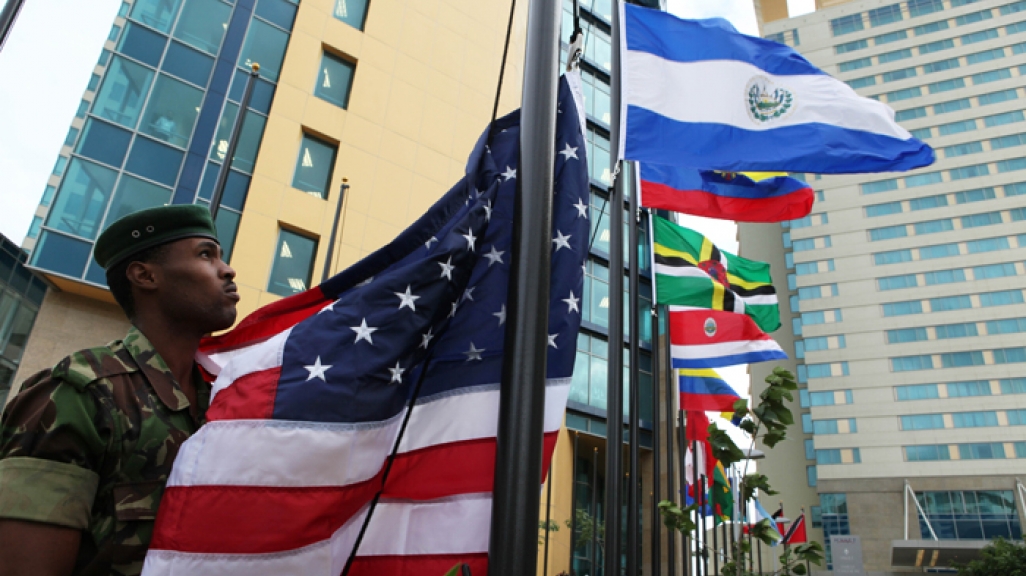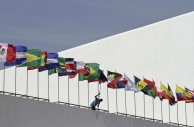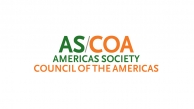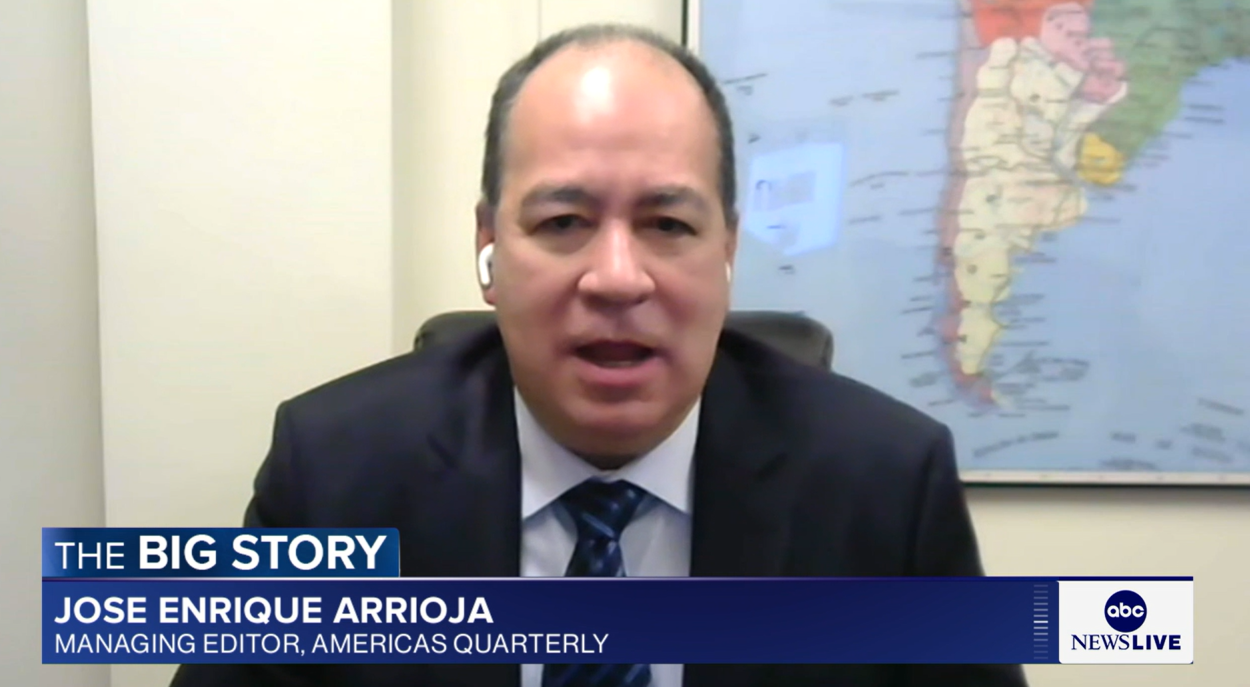Explainer: What Is the Summit of the Americas?
Explainer: What Is the Summit of the Americas?
AS/COA Online takes you inside the Summit of the Americas, providing a look at its origins, operations,and past summits' agendas.
The Summits of the Americas are among the most important fora for regional engagement, given that they serve as one of the few regular meetings to unite all democratically elected leaders in the Western Hemisphere. Though leaders have met every three to four years over the course of nearly three decades, the purpose of the meetings and what past Summits achieved can be lost to observers in the interim. Here, AS/COA Online provides a guide detailing the Summits’ origins, internal operations, and past achievements.
This article was originally published on April 11, 2012 and has since been updated.
The Summit of the Americas is a series of periodic meetings of democratically elected leaders of the Western Hemisphere. The first Summit was convened by U.S. President Bill Clinton in 1994 in Miami to develop a new relationship with the hemisphere in the post-Cold War environment. Since that first meeting, there have been seven Summits of the Americas and two special sessions. Summits of the Americas seek to regularize what were formerly ad hoc meetings of hemispheric leaders by formally convening every three to four years.
During a Summit, leaders of the participating countries and their delegations convene in the host city and meet for two or three days of discussions. Issues, determined by a pre-approved agenda, are presented at plenary sessions, and leaders and their delegations meet on the sidelines to determine how to advance. At the end of each Summit, the leaders often sign a declaration that summarizes summit conclusions, and a plan of action outlines steps countries agree to take to address the issues. While each Summit's agenda is distinct, all address issues of political, economic, and social importance. Past Summits focused on regional integration, trade issues, the strengthening and preservation of democracy, anti-corruption efforts, economic growth, poverty eradication, environmental sustainability, improved access to health and education, anti-discrimination programs, and control of narcotics.
Planning for each summit-including the agenda, time, and location-is determined by the Summit Implementation Review Group (SIRG). The SIRG is part of the Summit of the Americas Secretariat, which is in turn part of the Organization of American States (OAS). The SIRG is comprised of representatives from all participating countries of the Summit of the Americas and OAS members. The group meets at least three times annually to follow up on commitments made at previous Summits, determine issues to present at the next Summit based on input from member governments and presents its findings at regular OAS meetings. Countries that wish to host the Summit must submit a formal petition to the SIRG.
All democratically elected heads of state and government, as well as members of the OAS, are invited to attend the Summit of the Americas. Traditionally, Cuba has not participated, though it joined both the 2015 and 2018 Summits. In addition to regional leaders, representatives from 13 multilateral organizations, known together as the Joint Summit Work Group (JSWG), are invited as observers. Representatives of civil society, business, academia, and the media also participate. Invitations are at the discretion of the host country, which serves as Summit Chair, and executive of the SIRG.
The SIRG carries out enforcement of summit declarations. Members are aided in their efforts by the JSWG, which provides financial and technical assistance. Information on the implementation of Summit initiatives can be accessed through a database known as the Summit of the Americas Follow-up System (SISCA).
AS/COA’s Steve Liston shares background information on the upcoming Summit, to be held in June in Los Angeles.
The eight Summits and two special sessions held to date provided a forum to address regional concerns, and an opportunity to grow hemispheric relations. The framework of the Summits evolved over the years based on input from members. Individual summaries follow.
Miami, United States, 1994: First Summit of the Americas
Clinton convened the First Summit of the Americas to foster hemispheric relations in the new post-Cold War world order. With recent democratic transitions in many Latin American countries, the meeting stressed the hemisphere-wide promotion, strengthening, and preservation of democracy. Clinton announced plans for a Free Trade Area of the Americas (FTAA), which would set up a hemisphere-wide free trade area "from Canada to Chile." Members also agreed on the formation of the Inter-American Committee Against Terrorism and set up a framework for the organization of future summits.
Santa Cruz, Bolivia, 1996: Summit of the Americas on Sustainable Development
During the First Summit in Miami, participants resolved to follow Bolivian President Gonzálo Sánchez de Lozada's suggestion to host a meeting on sustainable development in his country. Leaders met in Santa Cruz to discuss the importance of sustainable development, declaring the need for equitable economic growth, social inclusion, environmental protection, and public participation. Members reached a consensus to address social and environmental concerns at future Summits.
Santiago, Chile, 1998: Second Summit of the Americas
In Santiago, members agreed to continue FTAA negotiations, planning to complete the project by 2005. Members also signed agreements assuring the hemispheric control of narcotics and freedom of expression, as well as continued efforts to strengthen democracy and free trade.
Quebec City, Canada, 2001: Third Summit of the Americas
The Summit in Quebec City proved a turning point for the Summit process, marking the regularity and success of the meetings, as well as unearthing challenges to moving forward. Negotiations for the FTAA continued in Quebec City, though some participants began expressing reservations. The Third Summit attracted protesters against the FTAA, with an estimated 60,000 people demonstrating in Quebec City over the course of the summit's proceedings. Besides FTAA negotiations, member states officially designated the OAS as the secretariat for the Summit of the Americas and increased the role of inter-American and civil-society groups in the summit process. Attendees also inked the Inter-American Democratic Charter.
Monterrey, Mexico, 2004: Special Summit of the Americas
Given changes since 2001-with a change of leadership in one-third of participating countries and serious economic challenges facing the hemisphere-the government of Canada proposed a special summit to promote hemispheric unity ahead of the Mar del Plata Summit. The agenda focused on economic issues with a special emphasis on poverty eradication.
Mar del Plata, Argentina, 2005: Fourth Summit of the Americas
The Mar del Plata Summit was defined by internal divisions over the FTAA. While the United States and 28 countries pressed to continue negotiations, Mercosur member countries (Argentina, Brazil, Paraguay, and Uruguay) as well as Venezuela declined, effectively ending the FTAA. Despite the failure of negotiations, members launched the Americas Competitiveness Forum, designed to aid business development in the hemisphere. As in Quebec City, the Mar del Plata Summit faced protests against the FTAA. U.S. President George W. Bush also attracted the ire of protesters over the Iraq War, and what many in host-country Argentina saw as Washington's "betrayal" of the country during their 2001 economic crisis. Sections of Mar del Plata experienced rioting. Venezuelan President Hugo Chávez also hosted an "anti-summit summit" simultaneously in protest of the FTAA.
Port of Spain, Trinidad and Tobago, 2009: Fifth Summit of the Americas
Some considered the Fifth Summit to be "a new opportunity" after the rancorous negotiations of Quebec City and Mar del Plata. With the FTAA defeated, the Fifth Summit was the first not to focus on trade. The Summit welcomed recently elected U.S. President Barack Obama, who promised to "launch a new chapter of engagement" with the region. Venezuela's Chávez addressed Cuba's exclusion from the Summit process; shortly after the Fifth Summit, the OAS lifted Cuba's membership ban, paving the way for future participation if the island met the democratic threshold. The declaration called for a "renewed spirit of cooperation," and members vowed to promote prosperity, education, energy security, and environmental sustainability in the face of the 2008-2009 global financial crisis. As such, members agreed to cooperate on natural disaster preparedness and response, and created the Inter-American Social Protection Network, which supports non-governmental organizations promoting social protection and development in the hemisphere.
Cartagena, Colombia, 2012: Sixth Summit of the Americas
The Sixth Summit encountered divisions over Cuba's continued exclusion from the meetings. While many Latin American countries argued in favor of Cuba's future inclusion, Canada and the United States remained firm in their position that Cuba did not meet the democratic threshold for participation. The two countries vetoed language in the Summit Declaration draft proposed by Argentina, Uruguay, and Venezuela that called for Cuba's participation in the next Summit. Bolivarian Alliance members threatened a boycott of the next Summit if Cuba was not present. Argentina's quest for hemispheric recognition of its Falklands claim was also unsuccessful due to U.S. neutrality on the matter, prompting Argentine President Cristina Fernández de Kirchner to leave the Summit early.
Despite these disagreements, attendees signed a number of bilateral pacts on regional integration, development, and cooperation. These agreements focused on energy, telecommunications, and education. A parallel CEO Summit of business leaders from throughout the Americas also took place. At the proposal of Guatemalan President Otto Pérez Molina, members agreed to have the OAS examine the effectiveness of current drug policy and evaluate alternative solutions.
In addition to the absence of Ecuadoran President Rafael Correa due to his boycott over Cuba's absence, Chávez and Nicaraguan President Daniel Ortega also did not attend. Chávez cited health concerns for his absence, while Ortega did not provide a reason.
Panama City, Panama, 2015: Seventh Summit of the Americas
The 2015 Summit's theme was "Prosperity with Equity: The Challenge of Cooperation in the Americas." It was the first to extend invitations to all 35 leaders across the hemisphere, including Cuba, which had renewed diplomatic relations with the United States after more than 50 years in December 2014.
A sit-down between the Cuban and U.S. presidents on April 11 dominated Summit news. Obama talked about the importance of creating "opportunities and resources for the Cuban people," while Cuban President Raúl Castro called Obama "an honest man" and said he was not responsible for the marred history between the two countries. Meanwhile, U.S.-Venezuela tensions-caused by U.S. sanctions on seven Venezuelan human rights offenders-temporarily cooled when Obama and Venezuelan President Nicolás Maduro had a brief, but cordial, encounter on the sidelines of the event.
Agreements on education and energy were among the most notable achievements of the Summit. At the behest of Colombia, all leaders agreed to establish an Inter-American Education System to boost education across the region through the research of effective strategies and policies. Leaders also agreed on several environmental mandates. The United States and other countries announced they would double their collective share of non-hydro renewable energy by 2030.
Lima, Peru, 2018: Eighth Summit of the Americas
U.S. President Donald Trump decided to cancel his visit days before the 2018 Summit due to an emergency in Syria, thus making Lima the first Summit missed by a U.S. head of state. In the months leading up to the event, Peru's foreign minister had uninvited Maduro on behalf of the Lima Group, a collection of regional states formed to address Venezuela's humanitarian crisis. The group cited Maduro's refusal to hold free and fair elections as the reason. Despite his absence, Maduro's regime remained a topic during the Summit, given that a million Venezuelans were estimated to have fled the country at that point.
Leaders focused on anti-corruption at this Summit, which was a particularly relevant issue, given that the host country's president, Pedro Pablo Kuczynski, resigned weeks prior to the event due to corruption allegations. Meanwhile, officials across the region were ensnared in the Odebrecht scandal.
Some of the key points in the Lima Commitment included the need to strengthen democratic institutions, improve transparency and access to information, and promotion of international legal cooperation.
A partnership between the public and private sectors is the best way to ensure equitable, inclusive, and sustainable growth for our region.
Los Angeles, United States, 2022: Ninth Summit of the Americas
After a year’s delay stemming from the Covid-19 pandemic, in January President Joe Biden announced that the next Summit will take place in Los Angeles during the week of June 6. The Summit’s theme will be: “Building a Sustainable, Resilient, and Equitable Future.”
Learn more about the Ninth summit and AS/COA’s related activities: https://www.as-coa.org/ixsummit











